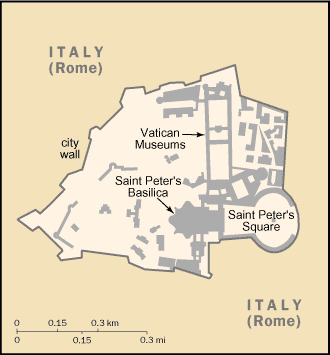|
Holy See (Vatican City)
|

|
Capital: Vatican City
Population: 799
Brief History of Holy See (Vatican City):
The Holy See is a separate country that is inside the city of Rome, Italy. It is also called Vatican City. There is a wall around the city and it is very small for a country; only 110 acres. It is owned and governed by the Catholic Church.
The history of the Holy See begins far back in the Catholic church. Starting in the 8th century, the Pope, or ruler of the Catholic church, ruled over the Papal States. This was a fairly large territory in Italy. In 1860, the Papal states were seized by Victor Emmanuel and the Pope only controlled the city of Rome. Soon, in 1870, the city of Rome was captured as well and made the new capital of Italy.
In 1929, the Italian Government agreed to create the Vatican City State that would be an independent country and governed by the Holy See. The Holy See is governed by the Catholic church with the Pope having supreme power over all aspects of the government.
The Geography of Holy See (Vatican City)
Total Size: 0 square km
Size Comparison: about 0.7 times the size of The Mall in Washington, DC
Geographical Coordinates: 41 54 N, 12 27 E
World Region or Continent: Europe
General Terrain: urban; low hill
Geographical Low Point: unnamed location 19 m
Geographical High Point: unnamed location 75 m
Climate: temperate; mild, rainy winters (September to May) with hot, dry summers (May to September)
Major cities:
The People of Holy See (Vatican City)
Type of Government: ecclesiastical
Languages Spoken: Italian, Latin, French, various other languages
Independence: 11 February 1929 (from Italy); note - the three treaties signed with Italy on 11 February 1929 acknowledged, among other things, the full sovereignty of the Vatican and established its territorial extent; however, the origin of the Papal States, which over the years have varied considerably in extent, may be traced back to the 8th century
National Holiday: Coronation Day of Pope BENEDICT XVI, 24 April (2005)
Nationality: none
Religions: Roman Catholic
National Symbol: crossed keys
National Anthem or Song: Inno e Marcia Pontificale (Hymn and Pontifical March); often called The Pontifical Hymn
Economy of Holy See (Vatican City)
Major Industries: printing; production of coins, medals, postage stamps; a small amount of mosaics and staff uniforms; worldwide banking and financial activities
Agricultural Products:
Natural Resources: none
Major Exports:
Major Imports:
Currency: euro (EUR)
National GDP:
** Source for population (2012 est.) and GDP (2011 est.) is CIA World Factbook.
Back to Geography Home Page
